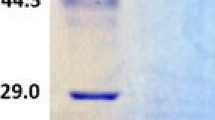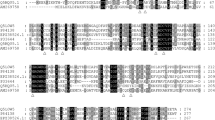Abstract
Laccase is a blue copper oxidase with multiple copper ions and widely distributed in higher plant and fungi. To date, numerous fungal laccases have been reported by many researchers. In present work, a new laccase gene, named CcLCC5I, from Coprinus cinereus was synthesized chemically according to the yeast bias codon and integrated into Pichia pastoris GS115 genome by electroporation. SDS-PAGE analysis showed that the recombinant laccase has a molecular mass of approximately 56.8 kDa. Its biochemical properties was carried out using substrate 2-2′-azino-bis(3-ethylbenzothiazoline-6-sulfonate) (ABTS). It was showed that the optimum pH and temperature of the laccase is 3.0 and 55 °C, respectively. Except for copper ions, most metal ions inhibited the laccase activity at a high concentration about 10 mM. Sodium sulfite can also highly inhibit laccase activity whereas EDTA had no inhibitory effect on the laccase activity. The CcLCC5I have high ability to decolor not only azo but also aryl methane dyes. The recombinant laccase decolored 44.6 % orange G, 54.8 % Crystal Violet, and 87.2 % Malachite green at about 2.6 h. The novel laccase may be a good candidate for breeding engineering strains used in the treatment of industrial effluent containing azo and aryl methane dyes.







Similar content being viewed by others
References
Messerschmidt A, Huber R (1990) The blue oxidases, ascorbate oxidase, laccase and ceruloplasmin Modelling and structural relationships. Eur J Biochem 187(2):341–352
Thurston CF (1994) The structure and function of fungal laccases. Microbiology 140:12–26
Mayer AM, Staples RC (2002) Laccase: new functions for an old enzyme. Phytochemistry 60:551–565
Claus H (2003) Laccases and their occurrence in prokaryotes. Arch Microbiol 179:145–150
Kiiskinen LL, Viikari L, Kruus K (2002) Purification and characterization of a novel laccase from the ascomycete Melanocarpus albomyces. Appl Microbiol Biotechnol 59(2–3):198–204. doi:10.1007/s00253-002-1012-x
Childs RE, Bardsley WG (1975) The steady-state kinetics of peroxidase with 2,2′-azino-bis-(3-ethyl-benzthiazoline-6-sulphonic acid) as chromogen. Biochem J 145(1):93–103
Prillinger H, Esser K (1975) The phenoloxidases of the ascomycete Podospora anserina XIII. Action and interaction of genes controlling the formation of laccase. Mol Gen Genet 156(3):333–345
Baldrian P (2006) Fungal laccases —occurrence and properties. FEMS Microbiol Rev 30:215–242
Patrik J, Hoegger (2004) The laccase gene family in Coprinopsis cinerea (Coprinus cinereus). Curr Genet 45:9–18
Jonsson LJ, Saloheimo M, Penttila M (1997) Laccase from the white-rot fungus Trametes versicolor: cDNA cloning of lcc1 and expression in Pichia pastoris. Curr Genet 32(6):425–430
Hirschhauser S, Frohlich J (2007) Multiplex PCR for species discrimination of Sclerotiniaceae by novel laccase introns. Int J Food Microbiol 118(2):151–157
Sun J (2011) Secretory expression and characterization of a soluble laccase from the Ganoderma lucidum strain 7071–9 in Pichia pastoris. Mol Biol Rep 39(4):3807–3814
Bao WH (2011) Expression, characterization and 2,4,6-trichlorophenol degradati- on of laccase from Monilinia fructigena. Mol Biol Rep 39(4):3871–3877
Xiong AS, Yao QH, Peng RH, Li X, Fan HQ, Cheng ZM, Li Y (2004) A simple, rapid. High-fidelity and cost-effective PCR-based two-step DNA synthesis method for long gene sequences.Nucleic Acids Res. 32(12):e98
Bradford MM (1976) A rapid and sensitive method for the quantitation of microgram quantities of protein utilizing the principle of protein-dye binding. Anal Biochem 72:248–254
Thitinard N, Akira W, Yasuhiko A (2010) Extracellular laccase produced by an edible basidiomycetous mushroom, Gridola frondosa: purification and characterization. Biosci Biotechnol Biochem 75(3):538–543
Biro JC (2008) Does codon bias have an evolutionary origin. Theor Biol Med Model 5:1–15
Fu XY, Zhao W, Xiong AS, Tian YS, Peng RH (2010) High expression of recombinant Streptomyces sp. S38 xylanase in Pichia pastoris by codon optimization and analysis of its biochemical properties. Mol Biol Rep. 38(8):4991–4997. doi:10.1007/s11033-010-0644-7
Cereghino GP, Cregg JM (1999) Applications of yeast in biotechnology: protein production and genetic analysis. Curr Opin Biotechnol 10(5):422–427
Lu L, Zhao M (2007) Purification and characterization of laccase from Pycnoporus sanguineus and decolorization of an anthraquinone dye by the enzyme. Appl Microbiol Biotechnol 74:1232–1239
Wang HX, Ng TB (2004) A novel laccase with fair thermostability from the edible wild mushroom (Albatrella dispansus). Biochem Biophys Res Commun 319(2):381–385. doi:10.1016/j.bbrc.2004.05.011
Park Park KM (2008) Purification and Characterization of Laccase from Basidiomycete Fomitella fraxinea. J Microbiol Biotechnol 18(4):670–675
Martin C, Pecyna M (2007) Purification and biochemical characterization of a laccase from the aquatic fungus Myrioconium sp. UHH 1-13-18-4 and molecular analys is of the laccase-encoding gene. Appl Microbiol Biotechnol 77:613–624. doi:10.1007/s00253-007-1207-2
Colao MC (2006) Heterologous expression of lcc1 gene from Trametes trogii in Pichia pastoris and characterization of the recombinant enzyme. Microb Cell Fact 5:31. doi:10.1186/1475-2859-5-31
Nagai M, Sato T, Watanabe H, Saito K, Kawata M, Enei H (2002) Purification and characterization of an extracellular laccase from the edible mushroom Lentinula edodes, and decolorization of chemically different dyes. Appl Microbiol Biotechnol 60(3):327–335
Liers C, Ullrich R (2007) Production, purification and partial enzymatic and molecular characterization of a laccase from the wood-rotting ascomycete Xylaria polymorpha. Enzyme Microb Technol 41:785–793
D’Annibale A, Celletti D, Felici M, DiMattia E, Giovannozzi-Sermanni G (1996) Substrate specificity of laccase from Lentinus edodes. Acta Biotechnol 16:257–270
Fukushima Y, Kirk TK (1995) Laccase component of the Ceriporiopsis subvermispora lignin-degrading system. Appl Environ Microbiol 61:872–876
Author information
Authors and Affiliations
Corresponding authors
Rights and permissions
About this article
Cite this article
Lin, Y., Zhang, Z., Tian, Y. et al. Purification and characterization of a novel laccase from Coprinus cinereus and decolorization of different chemically dyes. Mol Biol Rep 40, 1487–1494 (2013). https://doi.org/10.1007/s11033-012-2191-x
Received:
Accepted:
Published:
Issue Date:
DOI: https://doi.org/10.1007/s11033-012-2191-x




